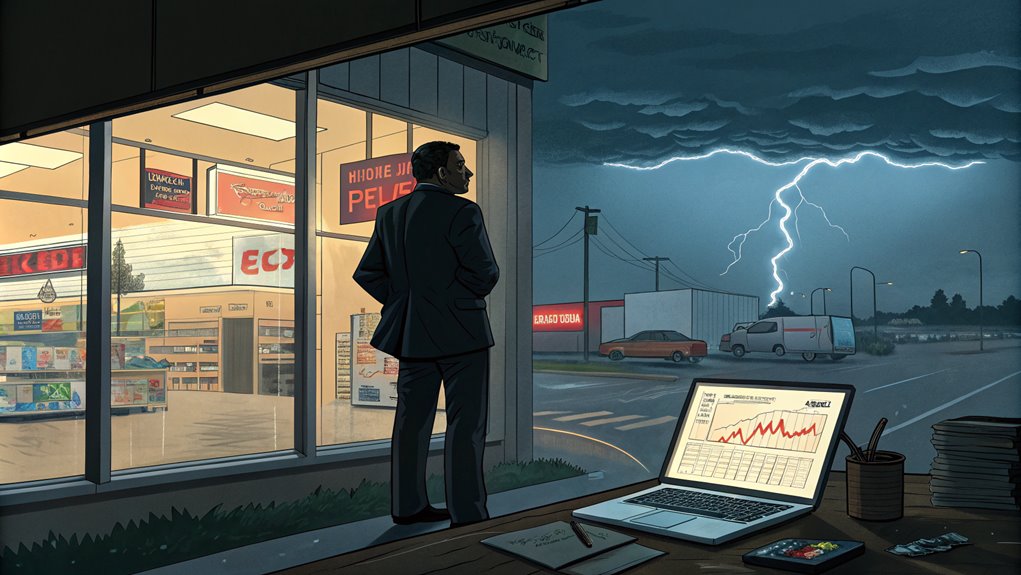Starting a business sounds exhilarating, right? The freedom, the control, the chance to do things your way.
Maybe you’ve even imagined that picture-perfect “work from anywhere” lifestyle, laptop open on a beach with a smoothie in hand.
But most businesses don’t make it past the first few years. And it’s not just because of the whole “no pain, no gain” cliché.
In truth? It’s risky.
We’re talking financial risks, emotional rollercoasters, endless hours, and a few choice existential crises in the middle of the night.
So, if you’re thinking about starting a business, consider this your welcome party to the very real, unfiltered world of entrepreneurship. Because yes, it’s incredible—but it’s also one heck of a ride.
TL;DR / Key Takeaways
- Starting a business is a high-stakes game. You could lose money, sleep, and maybe even your sanity if you’re not prepared.
- Risks and challenges? They’re everywhere. From financial strains and unpredictable income to self-doubt and burnout—it’s a package deal.
- Knowing what you’re up against is half the battle. With realistic expectations, you can actually set yourself up for success (or at least survive the first year).
15 Risks and Challenges of Starting a Business and How to Solve Them

Starting a business is an epic adventure where you’re up against market fluctuations, budget constraints, and late-night self-doubt. Each challenge is unique, but they’re all part of the game.
Understanding these risks and preparing solutions can help you avoid costly mistakes and build a resilient business. Here’s how to tackle some of the biggest hurdles in entrepreneurship:
Financial Instability
Most businesses don’t start with overflowing cash registers. Think less “instant millionaire” and more “living on ramen and black coffee.” Financial instability is often the first wake-up call for new entrepreneurs.
You’re pouring money into this dream—probably more than you expected—and it can feel like you’re just burning cash. Rent, utilities, product costs, marketing expenses… they don’t stop simply because you’re still trying to figure out how to get your first customer.
And if you’re bootstrapping? Get cozy with unpredictability.
For most business owners, the early days can mean months (or years) of barely breaking even. Take it from countless entrepreneurs who’ve been there: it’s nerve-wracking, and it tests your limits.
But here’s a small silver lining—learning to stretch a dollar and prioritize expenses is a skill that’ll make you a sharper, leaner business owner in the long run.
Solution: Start with a realistic budget that accounts for worst-case scenarios. Prioritize a cash buffer—at least three to six months of expenses—to help you ride out tough times. Don’t overspend on “nice-to-haves”; focus on essentials that directly impact growth. And track your finances religiously—cash flow statements, income projections, expense reports.
Market Competition
If you thought your idea was one-of-a-kind, let me introduce you to your competitors. In today’s market, no matter how niche your idea feels, chances are someone else is already there—or getting there soon.
Competition can be fierce, especially when big brands with bottomless budgets are in the same space. You’re the scrappy newcomer, and they’ve got a marketing team the size of a small army.
But here’s the upside: competition keeps you sharp. It forces you to find what makes you unique.
Your competitors might have the budget, but they don’t have your unique perspective, story, or brand voice. That’s where you can stand out.
And sometimes, the thing that sets you apart is just being a little more human, a little more relatable, than the industry giants.
Solution: Identify what makes you unique (your “secret sauce”) and emphasize it in every customer interaction. Study your competitors closely, find gaps in their offerings, and position yourself where they fall short. Focus on building strong relationships with your customers—authenticity and personalized service can give you an edge over big brands.
Lack of Experience
If you’ve never run a business before, you’re probably learning on the job—and the learning curve? It’s steep. It can feel like you’re trying to figure out how to fix a plane while it’s in the air.
Finance, marketing, customer service, logistics… there’s no single manual to follow, and even if there were, it’s different for everyone.
So, if you’re feeling overwhelmed, you’re not alone. Many entrepreneurs go in without experience and succeed because they’re constantly learning and adapting. That’s the beauty of it.
When you mess up (and you will), it’s not the end. It’s simply another lesson in your mental library. Just know it’s okay to ask for help—and remember, even the most seasoned business owners still have “what the heck am I doing” moments (and more often than you thin).
Solution: Admit what you don’t know and seek help. Take advantage of free resources—online courses, podcasts, mentorships, and industry meetups. Learn by doing but don’t hesitate to hire experts or consultants for areas where you’re totally green. Experience comes with time, so focus on learning and improving a little every day.
Uncertain Demand
One of the scariest questions to face: “Will anyone even want this?” You might think your product or service is pure genius, but that doesn’t mean the market will agree.
Testing demand is tricky, and it can be an expensive lesson if you jump in too fast without knowing if there’s a real customer base. And while market research can help, sometimes you’re just taking a calculated leap of faith.
It’s a balance of staying hopeful yet realistic. Sure, you want to believe there’s a market for your product, but it’s wise to test the waters early and adjust as needed.
Don’t be afraid to pivot—sometimes, the real winning idea is in the version 2.0 that you discover along the way.
Solution: Test your product or service before fully committing. This could mean launching a minimum viable product (MVP), running a pre-order campaign, or conducting surveys. Engage with potential customers and ask for feedback. Refine your offering based on what they actually want, not just what you think they want.
Regulatory Compliance
Regulations—the ultimate buzzkill. You might have the most innovative product in the world, but if it doesn’t meet regulations, you’re in for a world of hurt.
Compliance can mean different things depending on your industry: health and safety laws, data protection standards, employment laws, tax codes… the list goes on.
And they aren’t optional. One oversight can mean fines, legal fees, or even the end of your business before it really begins.
The key? Do your homework. Yes, it’s tedious, but understanding the rules is vital. If it’s overwhelming, consider bringing in a consultant or lawyer, at least to get the basics in place.
Compliance might not be the thrilling part of entrepreneurship, but it’s what keeps your business safe and operating above board. And let’s face it, dodging fines and lawsuits is always a win.
Solution: Start by identifying key regulations relevant to your industry. Research compliance basics and, if needed, consult a legal expert to ensure you’re covered. Regularly update your knowledge, as regulations can change. Also, document everything—permits, contracts, agreements—so you’re protected in case of audits or disputes.
Limited Resources
In an ideal world, you’d have unlimited resources—a pile of cash, a team of experts, and the best tools in the industry at your fingertips. In reality? You’ve got a modest budget, maybe a part-time assistant (who is also you), and software trials that keep expiring.
Limited resources can make you feel like you’re constantly stretching to cover all the gaps. Need a website, a marketing campaign, and product prototypes? You’ll have to choose one or get really creative.
But limited resources can make you resourceful. It forces you to focus on what actually matters, which in the end, might just make your business stronger.
As the saying goes, “Necessity is the mother of invention.” Many successful businesses started with nothing but a strong vision and sheer hustle. Remember, it’s not always about having more; it’s about making the most of what you’ve got.
Solution: Focus on resourceful strategies. Use free or low-cost tools, automate repetitive tasks, and prioritize projects with high impact and low cost. Barter services, if possible, and look for partnerships to share resources. If you’re bootstrapping, don’t underestimate the power of creative problem-solving.
Cash Flow Issues
Cash flow is one of those things that sounds boring until you’re the one trying to make payroll with a bank balance that looks way too close to zero.
A lot of profitable businesses fail because of cash flow problems. Sales might be up, but if payments are slow or your expenses hit all at once, it’s like watching water drain out of a leaky bucket—you’re constantly refilling, but it never feels full.
Managing cash flow requires discipline and a sharp eye. You’ll have to juggle timing, possibly even delay some plans to ensure there’s always cash on hand.
This is where you learn to plan for the worst and hope for the best. And yes, cash flow management might just turn you into a spreadsheet-loving budget hawk, but it’s better than scrambling for loans at the last minute.
Solution: Prioritize cash flow management by monitoring income and expenses closely. Set up a strict invoicing process to avoid late payments, and negotiate payment terms that work in your favor. Consider alternative funding options (like short-term loans or lines of credit) for emergencies, but avoid long-term debt that adds to your stress.
Time Commitment

Starting a business isn’t a 9-to-5 gig; it’s a 24/7 lifestyle. Those early days (and honestly, a lot of later days, too) demand your time and energy like nothing else.
Forget weekends, partying with friends, or even the idea of taking time off because you feel like it.
You’re the CEO, the janitor, the customer service rep, and the delivery driver all in one. Your business is basically your new best friend, your pet, and your wildest dream rolled into one. And like any intense relationship, it takes time—lots of it.
While the sacrifices can be overwhelming, you’re working toward something you believe in, which gives you a sense of purpose that’s hard to find in other jobs.
Yes, you’ll miss some parties, sleep, and maybe a few family dinners, but if it’s done right, the freedom you eventually gain can make it all worth it.
Solution: Create a realistic schedule that includes work-life boundaries. Prioritize tasks based on impact and delegate where possible. Automation tools can help streamline daily tasks, giving you more time to focus on growth. Remember, burnout helps no one, so take breaks and don’t be afraid to recharge.
Hiring and Managing Staff
Hiring and managing staff is one of those things that sounds great until you’re actually doing it. Hiring good people is challenging, especially when you’re starting out and might not have the budget to attract top talent.
And once you do hire, there’s a whole new skill set to learn: management. Because people are, well, people. They have needs, quirks, strengths, and weaknesses.
Figuring out how to motivate them, delegate effectively, and keep them aligned with your vision can feel like a full-time job.
Some days, it’ll feel like a juggling act—keeping clients happy, keeping the team happy, and trying to keep yourself sane.
You’ll learn to balance empathy with firmness, and praise with constructive feedback. And while managing a team can be exhausting, having the right people by your side can make the whole journey so much more rewarding.
Solution: Start by clearly defining each role you need to fill. Look for people who fit your company culture, not just skill requirements. Invest in good onboarding, offer clear communication, and foster an environment of trust. Leadership is about growth—if you invest in your team, they’ll invest in your business.
High Operational Costs
Operational costs are sneaky. You’ll have your main expenses—the obvious stuff like rent, utilities, inventory, and salaries. But there are also all those little costs you didn’t see coming: software subscriptions, unexpected repairs, equipment upgrades, insurance, legal fees… the list can feel endless.
High operational costs can quickly eat into your profits, leaving you wondering where all the money went.
The trick is to keep an eagle eye on your expenses. When you’re aware of where your money is going, you can make better decisions on where to cut back or invest.
And sometimes, you’ll need to get creative, finding ways to reduce overhead without sacrificing quality. It’s a constant balancing act, but once you start seeing where you can save, those hidden costs won’t feel quite so daunting.
Solution: Track all expenses and regularly review them for savings opportunities. Consider remote work options to reduce office expenses, negotiate with suppliers for better deals, and look for ways to streamline operations without sacrificing quality. Small savings add up, and every dollar saved is a dollar that strengthens your business.
Economic Downturns

Economic downturns show up out of nowhere and instantly ruin the vibe. Suddenly, consumers tighten their belts, spending slows, and businesses everywhere start feeling the pinch.
And if you’re the new kid on the block, you might feel it even more. An economic downturn doesn’t care if you’re just getting started or if your business is already thriving; it’ll test everyone equally.
Surviving these slumps often comes down to resilience and adaptability. Can you pivot? Cut unnecessary expenses? Find new ways to serve your customers?
The businesses that survive tough economic times are usually the ones that refuse to let the storm knock them down. And hey, if you can make it through a downturn, just think how strong your business will be on the other side.
Solution: Prepare a contingency plan that outlines how you’ll reduce expenses, conserve cash, and adapt your offerings if sales drop. Diversify income streams if possible, like adding a complementary product or service that aligns with customer needs during hard times. Flexibility is key—adapt quickly, and don’t be afraid to pivot if the market changes.
Technological Challenges
Here’s the thing about technology: it’s like quicksand. Every time you think you’ve got a handle on it, a new update or trend pops up, and suddenly, you’re back to square one.
Whether it’s software glitches, learning new tools, or figuring out how to leverage social media algorithms, staying on top of tech can feel like a full-time job.
And let’s not even get into the cost. Tech isn’t cheap, and upgrading systems or getting the latest software can eat into your budget fast. But here’s the flip side: staying tech-savvy is essential to staying relevant.
Adaptability here is your greatest asset. You don’t need to be a tech wizard; you just need to be open to learning and willing to ask for help when needed.
And hey, a few YouTube tutorials and tech support calls later, you might just surprise yourself.
Solution: Stay up-to-date by allocating time to learn new tools and tech relevant to your industry. If the tech world feels overwhelming, focus on mastering a few essentials—like accounting software, CRM systems, and social media tools. You don’t have to be an expert; you just need enough knowledge to run things efficiently or know when to hire help.
Supply Chain Disruptions
Supply chain disruptions are the stuff of nightmares. Visualize having orders lined up, customers waiting, and then—bam! Your supplies are delayed, costs go up, or your shipments are stuck somewhere far, far away.
Suddenly, you’re explaining to disappointed customers why their orders are late and watching your margins shrink. Fun, right?
Global events, natural disasters, even political shifts can throw a wrench into your supply chain without warning. It’s beyond frustrating, but it’s also an inevitable part of running a business.
Building strong relationships with reliable suppliers and having a backup plan can save you a lot of headaches. And remember, every hiccup in the supply chain is a lesson in resilience—teaching you how to prepare, adapt, and keep your business moving forward even when the unexpected hits.
Solution: Build strong relationships with multiple suppliers to reduce dependency on a single source. Diversify your suppliers geographically, if possible, to avoid regional disruptions. Keep a backup stock of essentials to cover short-term issues, and communicate with suppliers often so you’re aware of potential delays in advance.
Changing Consumer Preferences
If consumers were predictable, business would be a breeze. But the truth is, consumer preferences change. Rapidly. What’s popular today might be old news tomorrow, and keeping up can feel like trying to hit a moving target.
Today’s customers might want eco-friendly packaging, tomorrow they’re after ultra-personalized service—staying relevant requires constant listening, adapting, and sometimes completely rethinking your approach.
Changing consumer tastes can actually be a blessing in disguise. It gives you a reason to innovate, to push your brand into new and exciting directions.
Being flexible and responsive to what customers want can set you apart from competitors who are stuck in their ways. So, keep your ear to the ground, listen to feedback, and don’t be afraid to shake things up if the winds of change start blowing.
Solution: Regularly engage with customers and ask for feedback. Use surveys, social media polls, or direct conversations to gauge their needs and preferences. Monitor industry trends and be willing to adapt your products or marketing strategy as consumer tastes evolve. Flexibility and a customer-first mindset are your best assets here.
Cybersecurity Threats
Cybersecurity might not sound glamorous, but it’s non-negotiable. In a world where data breaches and hacking attempts are on the rise, protecting your business from cybersecurity threats is as vital as locking the front door.
What if you lost sensitive customer data or, worse, watched your hard-earned business reputation take a nosedive because of a security breach? Not exactly the PR boost you’re looking for.
Securing your business doesn’t have to be overly complex, but it does require vigilance. Strong passwords, two-factor authentication, and regular backups can go a long way.
And if you can afford it, investing in professional cybersecurity measures is always a smart move. At the end of the day, peace of mind is priceless—knowing your digital doors are locked tight so you can focus on growing your business without watching over your shoulder.
Solution: Start with basics like strong passwords, two-factor authentication, and secure data storage. Regularly update your software and train your team on security best practices. Consider hiring a cybersecurity consultant if your business handles sensitive data, and make sure you have a backup and recovery plan in place.
Personal Risk and Stress
Starting a business isn’t just risky financially—it’s a gamble on you. Every success feels euphoric, and every failure? Gut-wrenching.
If you’re the kind of person who values a peaceful, stress-free life, entrepreneurship might be the fast-track to personal chaos. Think of it as the world’s most intense personal growth program—where the stakes are high, and the lessons hit hard.
You’ll learn patience, resilience, and maybe a few breathing techniques along the way (trust me, they help).
But stress is part of the package. You’ll have days when you question everything, from your business idea to your life choices. And that’s okay.
Most entrepreneurs have a mental checklist of “worst-case scenarios,” and they push forward anyway. What keeps you going is that vision of what this business could become.
And as much as the stress is real, so is the reward when you see the pieces finally fall into place.
Solution: Establish a strong support network—friends, mentors, or even a business coach. Schedule regular mental health breaks, practice stress management techniques like meditation, and get comfortable asking for help. Remember, resilience doesn’t mean ignoring stress; it’s about managing it constructively.
Brand Building Difficulty
Brand building is an art—and a challenge. During an era where everyone is bombarded with ads, videos, and pop-ups, how do you get people to actually notice your brand?
It’s similar to shouting into a crowded room, hoping someone turns around. Building a brand takes time, consistency, and a clear message, which isn’t as easy as it sounds.
The hard part? Staying true to who you are while also standing out. It’s tempting to mimic successful brands, but customers can smell inauthenticity from a mile away.
So, start small. Define your values, your voice, and what makes your business unique. Even if your “brand” at first is just you showing up, being honest, and doing things differently, that’s enough.
People connect with realness, and that’s where your brand’s foundation lies.
Solution: Define your brand values and stick to them. Create a consistent visual style and tone for all communications, whether it’s on social media or in customer emails. Use storytelling to connect emotionally with your audience. Brand building is a marathon, so focus on delivering value and trust over time.
Finding Reliable Suppliers
Finding reliable suppliers is one of those things you might overlook—until you can’t. Picture your first big order coming in, only for your supplier to drop the ball. Cue the frantic emails and midnight calls.
Suppliers are a key part of your business’s backbone; without them, you’re scrambling. But finding reliable ones? It’s a bit like dating—trial and error, and sometimes a fair share of disappointment.
Building good relationships with suppliers can save you from countless headaches down the road. Take the time to vet them, ask for references, and don’t be afraid to walk away if they’re not delivering.
Reliable suppliers are out there; it’s just a matter of finding those who align with your standards and vision. And once you do, treat them well—it’s a partnership, after all, and both sides benefit when the trust is strong.
Solution: Do thorough research, ask for recommendations, and start small with new suppliers to test their reliability. Build strong communication, and foster a mutually beneficial relationship. Be clear about your needs and expectations, and always have a backup supplier in case things go south.
Scalability Issues

Scaling a business sounds great—until you try to actually do it. Scaling means expanding without losing control, and it comes with its own set of hurdles.
Maybe you’ve got demand for your product but not the infrastructure to keep up. Or perhaps you’re struggling to maintain quality as you grow. Scaling means finding that sweet spot between growth and stability and getting it wrong can mean the whole business starts to wobble.
Think of scaling as building a bigger house on an existing foundation. If the foundation isn’t strong, everything you add will strain it. That’s why so many small businesses hit a ceiling.
The goal? Create systems and processes that are scalable from the get-go. It might seem unnecessary in the beginning, but future you will be grateful when things start taking off and you’ve got the groundwork to support it.
Solution: Build scalable systems from day one—invest in software and processes that can grow with your business. Test your products and processes to identify and fix any weak points before you scale. Scaling doesn’t have to happen overnight; plan for steady, sustainable growth that you can manage effectively.
Intellectual Property Protection
In business, ideas are currency. And when you’ve poured time and energy into creating something original, the last thing you want is someone swooping in to copy it. That’s where intellectual property (IP) protection comes in.
Whether it’s trademarks, copyrights, or patents, protecting your IP can feel like one more task on an already overloaded to-do list. But without it, your business is vulnerable.
What if you spent years perfecting a product, only for a competitor to come in and replicate it? Not a great feeling, right?
IP protection is like insurance for your creativity. It’s there to safeguard what you’ve built so that you get to reap the rewards.
Yes, it can be a process, and it’s one that not every small business can afford right away, but understanding your options and prioritizing protection where it matters most can save you a lot of hassle (and potential legal battles) down the road.
Solution: Protect your unique ideas and products by exploring trademark, copyright, and patent options. Consult with a lawyer if needed, especially for sensitive IP. Document your work to have a paper trail if legal issues arise, and be proactive about enforcing your rights if you encounter copycats.
Conclusion
Starting a business is thrilling, unpredictable, and honestly, a little terrifying. The risks and challenges of starting a business are real—from financial instability and competitive pressures to personal stress and constant adaptation.
But every challenge is a stepping stone, every risk an opportunity to learn. And while there’s no magic formula to guarantee success, understanding the road ahead—and embracing it with both eyes open—gives you a serious edge.
You’ve got this; now go make your mark.
FAQs
1. What are the risks of starting a business?
Starting a business carries financial, emotional, and operational risks. Success requires navigating market competition, cash flow challenges, and personal stress effectively.
2. What’s the biggest challenge for a startup?
The biggest challenge is balancing growth with stability. Startups must focus on building a strong foundation while adapting to evolving market conditions.
3. How can a new business manage financial risks?
Prioritize cash flow management, minimize unnecessary expenses, and plan for downturns. Building a financial buffer early on helps handle unexpected costs.
4. Why is the risk of starting a business high?
New businesses face unstable income, market competition, and operational hurdles. Success depends on resilience, adaptability, and smart financial planning.
5. What common risks do small business owners face?
Small business owners face cash flow issues, competition, and scaling challenges. Finding reliable suppliers and managing regulatory compliance are also common.
6. Why is a business plan essential?
A business plan is your roadmap, helping you define goals, identify potential challenges, and set realistic expectations to guide decision-making and growth.
7. What’s the best way to raise capital for a business?
Options include personal savings, loans, investors, and crowdfunding. Choose based on your needs, growth potential, and willingness to share equity or debt.
8. How can I find the right customers?
Identify your target audience by researching market trends and consumer needs. Tailor your marketing approach to reach people genuinely interested in your product.
9. How do I hire the right people for my business?
Define roles clearly, seek referrals, and evaluate both skills and cultural fit. Hiring people who share your vision is key to building a strong, cohesive team.
10. What makes a good business idea successful?
A good business idea meets real market needs, offers something unique, and is scalable. Researching demand and adjusting to customer feedback helps ensure success.
Meta Description: Discover the common risks and challenges of starting a business as an entrepreneur alongside strategies to tackle startup financial instability, competition, and more.
Article Tags: business risks, startup challenges, financial instability, market competition, brand building, cash flow issues, hiring challenges, small business advice, business strategy, risk management, business growth, entrepreneur tips, scalability, operational costs,









